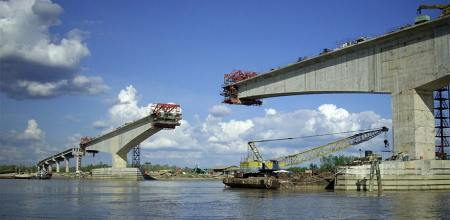Expert Tips: Introduction to Time-dependent Analysis for Concrete Structures

Author: Seungwoo Lee, Ph.D., P.E., S.E.
Publish Date: 12 Jul, 2021
Before starting the rigorous discussion about time-dependent analysis, let's start a simple structural analysis problem.
What is the reaction R1 for the blow fixed end beam?

Figure 1. Fix end support beam with uniformly distributed load (Source: https://structx.com).
From various formula tables, R1=3wL/8. Is this correct?
This is correct only if the entire structure is built together at the same time. What would happen if support 1 is added later? Let's assume that the cantilever part is built first and then support 1 is attached to the deformed cantilever.
In this case, R1=0.
This simple example shows the importance of the construction stage analysis. For concrete bridges, the dead load is the major load and we cannot get meaningful results without construction stage analysis if the structural system is changed during the construction process.

Figure 2. Cantilever structure during construction and indeterminate frames (Source: https://theconstructor.org).
Let's think about deflection. What is the tip deflection for the cantilever beam below?

Figure 3.
From various formula tables, Δ = wL4/(8EI). Is this correct?
This is correct only if we ignore the effects of creep: for concrete structures, strain increases even under constant stresses. In other words, deflection increases without load increases.
Creep coefficient is defined as [creep strain]/[elastic strain].
[Total strain]
= [Elastic strain] + [Creep strain]
= [Elastic strain] + [Creep coefficient] [Elastic strain]
= [Elastic strain] [1+Creep coefficient]
Creep coefficient φ(t, t0) is a function of the age at loading t0 and the age t for which the strain is calculated. If we pour concrete on 02/17/2021, remove falsework on 02/24/2021, and want to calculate the creep coefficient for 02/16/2031, t0 = 7 days and t = (10)(365)+2 = 3652 days.
The calculation of creep coefficient φ(t, t0) is very straightforward from code, and CEP-FIP is the one of the most commonly used.
Assume a cantilever beam is built at age t0, support at the tip is added at age t1, and we want to calculate the reactions at age t2, sometime later than t1. (Example 6-1, Concrete Structures, 3rd. ed., by Dr. Ghali, et al.).

Figure 4.
First, consider the tip deflection. The tip deflection at age t0 is
Δ(t0) = wL4/[8E(t0)I],
where E(t0) is the elastic modulus of concrete at t0. E(t) varies as time passes.
At age t1, the tip deflection is
Δ(t1) = Δ(t0)(1 + φ(t1, t0)).
If this deflection is free to occur up to age t2, i.e., if we never add the support, the tip deflection would be
Δ(t2) = Δ(t0)(1 + φ(t2, t0)).
The deflection
Δ(t2) - Δ(t1) = Δ(t0)(φ(t2, t0) - φ(t1, t0)),
is "restrained" due to the tip support, which we added at age t1, and internal forces are redistributed between age t1 and t2.
This is also called "moment redistribution due to creep", and understanding this concept is essential to design segmental bridges.




Add a Comment